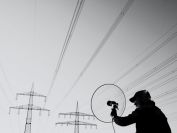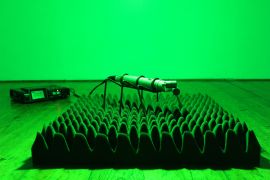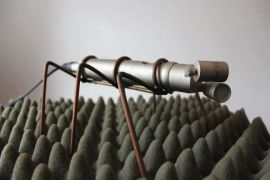This article examines the microphone and how it connects political and non-human contexts. A media archaeological excavation of Leon Theremin’s role in the development of a specific bugging device (“The Thing”) facilitates discussion throughout. Situating the microphone within a networked history of power relations and ethical consequences, the author draws upon contexts of surveillance, parasites and horror in order to ask whether microphones serve as active agents and, if so, what the consequences might be.
Recent literature within sound studies has focused on the act of listening as central to contemporary praxis and discourse1. As a consequence, the microphone — sound arts’ core methodological tool — has been overlooked in pursuit of the essentialized ear or been circumnavigated in favor of art historical mappings2.
Critical microphonic debate lags under the weight of its normative application as a tool of servitude that facilitates the audiophile’s pursuit of fidelity. The following writing therefore aims to generate new critical debate around the microphone and its complex relationship to nonhuman agency. In addition to examining the implications of Leon Theremin’s microphonic bug, I apply Bruno Latour’s Actor-Network Theory (ANT) as a critical lens in order to draw out the microphone’s “actant” potentiality. Finally, I look at how Marcel O’Gorman’s theory of “necromedia” propels the microphone and its consequent representations toward the horrific.
Theremin’s “Thing”
Ask most people about musical inventor and composer Leon Theremin and they will tell you he invented a musical instrument that can be played without actually putting your hands on anything. This of course is true, but like most people Theremin has other stories, one of which involves his pivotal role in a covert eavesdropping operation at the height of the Cold War.
Theremin was the creator of a unique listening device (bug) that was housed within the carved front of the Great Seal of the United States. Presented as a gift on 4 July 1945 to Averell Harriman, U.S. ambassador to Moscow, the plaque was mounted on a wall inside his Moscow office3. Unbeknownst to Harriman or any other U.S. official, behind the eagle’s beak adorning the plaque lay Theremin’s unique listening device. The microphone was small and had no power supply or active electronic components. It consisted of a passive cavity resonator, which became active only when a specific radio frequency was sent to the device from an external transmitter4. This meant the bug could reside in secrecy and function for a potentially unlimited time. For seven years and over the tenure of four U.S. ambassadors, Theremin’s bug relayed confidential information to the remote ears of intelligence operatives. The name assigned to Theremin’s microphonic creation was “The Thing.”
Material Bodies
The term “bug” can be traced to Admiral Grace Hopper, a Navy computer scientist who grafted the word into technovocabulary when she found the body of a moth interrupting the physical circuits of the first electronic computer she was programming5. The inaugural “debugging” was achieved simply by removing the corpse. Hopper’s moth incident took place just months after Theremin’s own bug made its stealthy way into office6.
Animal augmentation was rife in early electrical experiments, which often involved ox heads and frogs’ legs. The galvanometer—an instrument for detecting electric current—paved a specific pathway for the telephone industry and, by proxy, the invention and application of the microphone7. Further underscoring the entanglement of nonhumans and sonic media, the Lac beetle is perhaps the most potent bodily connection. The resin secreted from the female insect across the forests of India and Thailand fueled the gramophone industry and in doing so reinforced the point that humans, animals and media are not mutually exclusive with regard to their histories and relationships8.
Theremin’s Thing carries an amusing amalgamation of associative bodies: a bug, an eagle’s beak, a nation’s great seal and a rather crypto-horror name for the microphone itself. Aside from these medianatures9, however, we have the question: What is the Thing’s function? What can we say of its agential capability? Could this microphone be deemed parasitical during its seven-year residence in the ambassador’s office?
Parasitical Agency
Theremin’s device was the first passive microphone of its kind. Such technical passivity is transformed through its agential capability. Feminist theorist and philosopher Karen Barad defines agency not as an attribute but as a doing, enacted continually through performative potentiality10. As a result, things are transformed through their ongoing relations: “apparatuses are themselves phenomena”11. In other words, things, in their relation to other things, become more than their anthropocentric function. Theremin’s bug certainly performed a form of listening over the course of its seven-year residence; its technical passivity should not obfuscate its active agential becoming.
Philosopher of science Bruno Latour’s Actor-Network Theory (ANT) offers a useful critical context within which to situate such discussions. Underpinning much recent posthuman philosophy, including Object Oriented Ontology12, Speculative Realism13 and New Materialism14, ANT is primarily concerned with how humans and nonhumans, including media technologies, come to form networked relationships. Such relations are always in flux due to the constant performance of actors (microbes, humans and technology). Actors are interconnected through the way they make others “do things”15. Importantly for the microphone, “ANT is not the empty claim that objects do things ‘instead’ of human actors”16. Within this network of relations, “each participant is treated as a full-blown mediator … where all the actors do something”17. Mediators “transform, translate, distort, and modify the meaning or the elements they are supposed to carry”18.
Similarly, I would argue that the microphonic actor is not autonomous in and of itself, nor is it an impartial tool of servitude. It is a distortion mediator that performs agency in active relation to others, and it is contained within a web of cause and effect, human and nonhuman, material and immaterial performativity. The importance of ANT for any microphone, then, is that it makes clear that the emphasis resides on relations and effects. This is a key point in what I am arguing in this article—that to grip the microphone is to extend oneself into a network of histories and power relations. The resulting consequence for sound studies and particular genres such as field recording is that capturing sound can never be neutral. The resulting audio document can likewise never claim ethico-aesthetic impunity or function as a “pure” representation.
Bytes Hurt
Typically parasites do not kill their hosts but live in, off and on them, deriving nutrients over an extended period of time. Parasites are smaller than their hosts, the smallest being bacterial agents that are undetectable unless microscopically analyzed. In many cases it is impossible to prove that harm is done to a host.
Theremin’s Thing resided unknown to its host, the U.S. embassy, draining information without any tangible sign of harm. The microphone, like the parasite, could be said to leave no trace. Yet the Thing did have an effect. At the very least it would have influenced decisions in such a way that we cannot rule out its impact. As Albert Glinsky notes, the Hiroshima and Nagasaki bombings occurred as the Thing made its way into office19.
The radio waves that stirred the Thing’s techno-slumber triggered a relentless reawakening and metamorphosed the microphonic agent from parasite to zombie slave. Although seemingly autonomous and invisible to its host, it was nonetheless connected to human ears and hands via the radio signals that manipulated its performance. The Thing’s remote listeners were tied into a material world of labor and political endeavor. The Thing was a connective grafting of the human, animal and technological: amalgamated membranes and diaphragms that produced consequences in spite of seeming immateriality.
Through such ANT analysis, the Thing, and by proxy any microphone, can be read not only as something that “sucks” but also something that “spreads.” Much like bacteria or a virus, the microphone is a contagious performer. As with any bacteria that can cause disease and decay, so too then can we say the microphone, as viral bug, has the potential to infect; microphones are never passive in their continual transformation of an environment; they are alive and kicking(!).
Such performative agency was even recognized in 1878, as an article in the New York Times makes clear throughout its sustained attack on Thomas Edison, a man apparently “addicted to electricity”20. The news report lambasts the microphone for its ability to audit private conversations, prompting the bold proclamation that it is an “atrocious instrument … devastating in its effects”21.
Hacked to Death
Animals are repeatedly hacked in microphonic history, both materially and through associative borrowing22. Histories of surveillance and espionage bring pertinent examples. The CIA-led 1960s project Acoustic Kitty was an infamous case, in which a cat had a microphone surgically implanted in its ear, a transmitter implanted in the base of its skull, and wire entwined in its fur23. Such military-industrial engineering inevitably finds its channels of power through the “humanimentical” agent24 (Fig. 1).
To hack literally means to “cut through”; one can “hack” meat or branches. Hack also means to “gain unauthorized access.” The microphone hacks humans and environments and, perhaps more physically, nonhuman bodies due to asymmetrical relations of power. The microphone constantly produces a transgression, fusing material and metaphorical hybrids along the way. As author Eugene Thacker makes clear, crossing borders and breaching limits is what typifies the horror genre25. Philosopher Dylan Trigg states that “horror involves the intersection of the human and nonhuman”26. Hence the microphone comes to reflect something built out of the horrific: a chimeric indexer of border crossings that continually splits or spits outward, into and through its subjects. There is a latent horror therefore within the microphone, an instrument that hacks away at spatial and bodily borders27.
In filmmaker John Carpenter’s horror movie The Thing (1982), an alien parasitical creature replicates its hosts. This process is never one of exact mimesis; rather it is a crosshatching of identities and material energies that spawn collisions of the human and nonhuman. Similarly, the microphone produces nonrepresentational assemblages through its own idiosyncratic process of capture. It does not do so in autonomous isolation. Instead it holds on to human hands and power relationships that shape the sociopolitical world. Hence, a microphone can never be employed as an inanimate or anonymous device. It connects to a political ecology of subjectivity and power: a latticing of humans, nonhumans, technologies and media histories. Its consequent representations (recordings) forge a pathway toward monstrous potentiality rather than any singular notion of reality.
Within this horrific context the microphone becomes a “necromedia actant.” As media activist Marcel O’Gorman’s book Necromedia (2015) amplifies the entanglement of technology and death, the microphone too, like the camera, sits within a similar thanatological context. “Rifle” and “shotgun” models that make up recording kits further this parallel techno-death drive. Issues of tracking, plundering and predation internally stalk genres such as field recording and should be acknowledged as a counterweight to the altruism that stems from acoustic ecology legacies and the presumed inconsequentiality of capturing environmental sound.
O’Gorman marks out the difference between terror and horror, suggesting that terror is the ongoing pursuit of something never quite there, while horror is the point of stumbling upon the corpse—a moment that is typified by its frozen revelation28. Field recordists, and sound as a medium, may simply be terrorizing one another through an endless peripatetic pursuit—like a snake eating its own tail. If this is the case, I can also speculate that the recorded representations— which find homes in archives, CDs or installations—are in fact suspended moments of horror.
Through such necromedia questioning of the microphone, we begin to disturb the very act of recording sound and open up new questions that draw upon the parasitical and horrific: Does the hand grip the microphone or does the microphone grip the hand? If the microphone hacks its way through bodies and space, what can we say about the consequent recorded document? What is really being captured other than the socalled signal?
Conclusion
How then was Leon Theremin’s microphonic bug discovered, and what happened when it was?
A British radio operator overheard the voice of thenAmbassador George F. Kennan on an open radio channel as radio waves were being fired at the device in order to activate it. U.S. technicians used electronic sweepers to fire frequencies inside the ambassador’s office until the Thing gave a “howl” of feedback, revealing itself through its own creaturely scream. Also known as “parasitic oscillation,” feedback comes to symbolize a type of audial self-horror, an uncanny moment in which a mirror is held up and the self’s true abomination is revealed.
As with Hopper’s moth, debugging the Thing involved its physical removal from the host. It does not feel far-fetched to imagine the microphone being picked up, legs squirming as it let out its howl of self-horror29. The U.S. ambassador’s dictated notes on this event allude to the Thing’s sinister agential identity: “One was acutely conscious of the unseen presence in the room of a third person: our attentive monitor. It seemed that one could almost hear his breathing”30.
The thing about microphones is that a seemingly anonymous piece of technology is in fact a performative agent, one that actively queers histories of the human and nonhuman through a material and speculative webbing of power and ethics.
This article was published in The MIT Press Journals, vol. 26, December 2016 [p.60-63].



